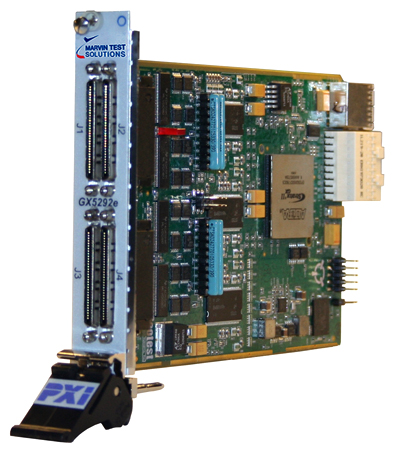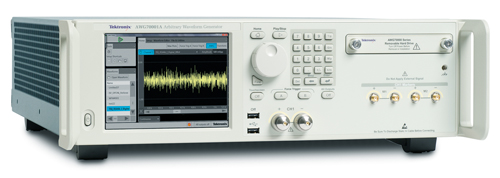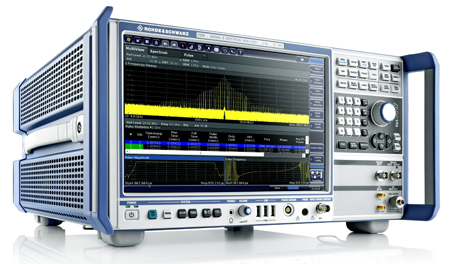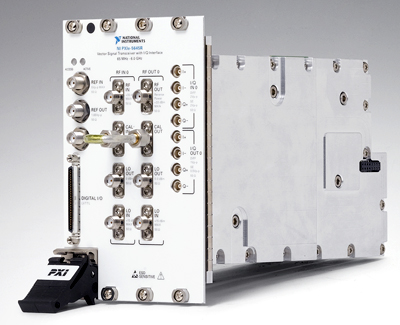Source: EE
Modern complex radar systems with wide bandwidths present significant test challenges. Further, they often present narrow pulses or exhibit inter-pulse behavior that further challenge test equipment. Fortunately, a variety of modular and benchtop instruments and related software is available to meet the challenges.
Phyllis Cosentino, product marketing manager for RF and wireless test at National Instruments, concisely summed up the radar test challenge: “Customers are continually looking for wider bandwidth for testing radar applications.”
Richard Duvall, technical marketing manager at Tektronix, elaborated on some of the test difficulties that radar presents. “More and more, modern radar systems are being implemented as digital or software-defined radios,” he said, which “is driving the need to test the radar transceiver chain at each stage, including digital I/Q signal injection.”
Moreover, he said, “When using phased antennas, it is important to delay signals at each antenna element by a precise amount so that the array’s main lobe can be steered. It is important to perform very precise and fast detection and tracking of targets with low reflected energy. This requires phase shifters in the system to produce minimum distortion.”
Bob Buxton, manager of product marketing, microwave benchtop products at Anritsu, said, “Advances in radar systems are requiring test instruments with greater precision to measure narrower pulse widths and/or examine intra-pulse behavior with finer resolution—including a closer look at rise/fall edge effects or the profile within a pulse compression signal.”
Mike Dewey, senior product marketing manager at Marvin Test Solutions (MTS), said, “What we see is an ongoing trend to larger phased arrays, which in turn drives the need for more complex systems.” He added, “Our ability to offer high-performance and high channel-count baseband test solutions/subsystems helps to mitigate the complexity and technical challenges associated with testing/verifying these systems.”
For radar test, Dewey said MTS focuses on products that support baseband applications. These products, he said, are PXI-based, adding, “Typically, our products are being used to support the high speed and large amounts of digital data that are associated with phased-array antennas and digitized after downconversion.” Dewey cited another consideration: “One of the requirements we have seen evolving is that with higher data rates it is necessary to support not just TTL, but also LVDS signaling. Many of our high-performance digital cards offer support for both logic families, providing customers with the flexibility to address both types of logic interfaces with the same card.”
Specific MTS products with radar-test applicability include high-speed PXI digital instruments with deep memory (256 Mb/channel) with sampling rates of up to 200 MHz, such as the GX5293 3U PXI card and the GX5292e instrument (Figure 1). “These single-slot PXI cards feature 32 channels, making them ideal for building high channel-count, high-performance data-generation/capture systems,” Dewey said. “These systems have been incorporated into complete radar systems for the purpose of testing/verifying new designs and/or production equipment.”

Figure 1. GX5292e 3U PXI Express Dynamic Digital I/O Board
Courtesy of Marvin Test Solutions
For radar, EW, and ECM signal capture, analysis, and generation, Aeroflex offers the Aeroflex Advanced Waveform Analysis, Recording, and Emulation System (AWARES). “AWARESs,” said Mark Prichard, business development technologist at Aeroflex Test Solutions, “are broadband, deep-memory hardware-based systems that have the flexibility, bandwidth, RF range, and processing power to create or analyze almost any complex RF environment, making them ideal for R&D, waveform development and verification, production test, laboratory test, and field system evaluation. These systems are compact and modular, replacing racks of specialized legacy test hardware.”
Systems and Software
“For MIL/Aero radar applications, Agilent Technologies supplies high-performance test and measurement equipment and systems as well as design and simulation software solutions,” said Greg Jue and John Hansen, Agilent application engineers. “To enhance the usability of our instruments, we offer many different types of software tools that enable the user to quickly simulate and analyze analog, RF, and digital signals needed for MIL/Aero radar design and test applications.”
Bench vs. Modular
Jue and Hansen said Agilent offers both modular (in PXI and AXIe form factors) and bench instruments so that customers can select either based on their performance and form-factor requirements. “High-performance bench instruments continue to be well suited to R&D where customers have unbounded and unpredictable measurement requirements,” they said. “Modular products also are available for a variety of demanding high-performance applications.” They added that Agilent’s measurement science and applications software are common across benchtop instruments and modular products, thereby providing consistent measurements for both categories.
“Modern radar systems are using wider bandwidths, which presents new testing challenges,” they said, adding that Agilent addresses these challenges with its 12-GS/s AXIe-based M8190A arbitrary waveform generator (AWG). The AWG can be combined with a PSG signal generator (up to 44 GHz) with I/Q inputs to generate signals such as a 2-GHz LFM chirped radar signal at X-band. “Wideband analysis can be performed with a 62-GHz Q-series Infiniium oscilloscope and 89600 VSA software,” they concluded.
Prichard at Aeroflex elaborated on modular implementations, saying, “Modular technology allows for the creation of application-specific instrumentation from standard hardware and software subcomponents. The reconfiguration of software usually is the only development resource required to tailor these types of instruments to an application.”
On the other hand, he added, “In general, bench instruments are designed around a defined-technology application. In this age of expanding requirements in EW and related fields, modular technology is the only solution that can be termed ‘future ready.’”
Cosentino at NI cited one unique capability of the NI approach—the capability to combine FPGAs that can be programmed using NI LabVIEW software with an RF front end, allowing customers to configure unique test systems. “For example,” she said, “customers solve problems such as target emulation by emulating an actual radar target using instrumentation. They do this by leveraging the high-performance wideband front end in conjunction with the user-programmable FPGA.” LabVIEW, she said, has a wide range of system-design modules and provides everything from a basic FFT to an FM demodulation module. Therefore, she said, customers can “readily create their own customized software for their specific radar applications and to successfully devise a wide variety of functional tests.”
Said Dewey at MTS, “In terms of the high channel-count associated with phased array radar systems, PXI (modular architecture) offers the performance and small footprint that bench instruments cannot match.” He added, however, “For RF/microwave sources, bench instruments still seem to have the edge in performance. Additionally, the size of microwave/RF components still is the limiting factor in downsizing PXI microwave sources to compact PXI modules.”
Buxton at Anritsu concurred with that assessment. “Bench instruments offer improved performance in areas such as dynamic range and noise floor,” he said. “This allows testing radar systems down to very low power levels for sensitive receivers.”
Benchtop Instruments
Whereas MTS focuses on baseband I/O boards, Anritsu offers its VectorStar MS4640B Vector Network Analyzer (VNA), which is designed with an advanced architecture that allows engineers to conduct highly accurate radar pulse measurements (Figure 2). “It incorporates an innovative high-speed digitizer and PulseView advanced viewing and analysis software that helps to eliminate trade-offs and limitations of other test methods by delivering higher resolution, greater timing accuracy, longer record lengths, and an advanced graphical setup display,” he said.
PulseView, Buxton explained, is a new pulse measurement UI that offers real-time parameter modifications for increased confidence in setting up measurements. “With PulseView,” he said, “engineers get the ‘true view’ of how their DUT is behaving because it provides the industry’s longest pulse measurement record length.”
Anritsu also offers signal generators for radar applications. “Installing the DFS radar option in the MG3710A Vector Signal Generator supports output of TELEC-T403 and FCC06-96 test signals,” Buxton said. “The MG3710A, with the option installed, simplifies the output of complex combinations of pulse, chirp, and hopping signals that are required to conduct DFS signal analysis. The MG3710A supports two built-in vector signal generators with two RF inputs, which allows different frequencies, levels, and waveform patterns to be sent independently.”
In addition, Anritsu offers the MG3690C Series of microwave signal generators, which, Buxton said, feature low phase noise and fast 5-ms frequency changes. They can produce independent singlet, doublet, triplet, and quadruplet pulses. “A versatile solution,” Buxton said, “the signal generator can be used in radar simulation of multiple doublet returns and to simulate moving targets in radar applications.”
Anritsu also provides portable instruments. “For field radar testing,” Buxton said, “the VNA Master MS202xC/3xC Series microwave VNAs feature time-domain gating that makes it easier to conduct radar cross section (RCS) tests on the flight line or in the field. The compact handheld multifunction instrument offers a portable yet powerful VNA, allowing engineers and technicians to conduct S-parameter analysis in challenging environments.”
Tektronix focuses on bench-style instruments. Duvall said that for radar test, Tektronix offers AWG7000 and AWG70000 Series AWGs (Figure 3), which provide the RF and IF signal generation capabilities that are “invaluable for transceiver chain testing.” Both AWG series instruments, he added, have multiple channel outputs that can be used to test advanced phased-array antenna implementations, which utilize beam-forming techniques. “The Tektronix AWG offers the capability to rotate the phase in increments as fine as 0.1 degree to allow for testing the receiver sensitivity to phase changes,” he said. The AWGs are complemented by RFXpress software, which supports direct-synthesis RF or baseband generation on the AWGs.

|
Figure 3. AWG70000 Series Arbitrary Waveform Generator
Courtesy of Tektronix
|
Tektronix also markets signal-analysis instruments for radar-test applications, including RSA5100B Series real-time spectrum analyzers, which, Duvall said, can discover and characterize pulsed, short-duration, and frequency-varying RF signals. In addition, the company offers the RSA6000 Series real-time spectrum analyzers with DPX Live RF spectrum display.
“The RSA Series enables DPX Live RF spectrum display on up to 165-MHz acquisition bandwidth,” Duvall said. “The hardware processor performs up to 292,969 FFTs per second,” thereby giving continuous real-time visibility of varying RF signals without interruption. “The uninterrupted visibility guarantees 100% probability of intercept of signals or transients as short as 3.7 µs because there is no dead time,” he said. “The DPX spectrum display is observing all the time. Interference to radar pulses and situations of multiple signals on the same frequency can all be discovered.”
Rohde & Schwarz also addresses radar test applications. “Rohde & Schwarz has a complete portfolio of hardware, software, and systems solutions for all aspects of radar test,” said Darren McCarthy, a technical marketing manager at the company.
For example, the recently introduced R&S FSW-B500 hardware option expands the analysis bandwidth for R&S FSW high-end signal and spectrum analyzers (Figure 4) to 500 MHz. The analyzer is suited for sophisticated measurement tasks in radar or satellite applications. McCarthy said a dedicated software option, K6 Pulse Measurements, performs 40 automatic pulse, pulse-to-pulse, and pulse-trend measurements.

|
Figure 4. R&S FSW Signal and Spectrum Analyzers
Courtesy of Rohde & Schwarz
|
In addition, he said, a portfolio of signal generators (analog and vector) is supported with pulse-generation software for receiver test, signal LO substitution, and component test. And the NRP peak power sensors and the R&S ZVA network analyzers can test radar performance.
To test complex active electronically scanned array (AESA) radars, Rohde & Schwarz offers the TS6710 T/R Module Radar Test System and
In addition, he said, a portfolio of signal generators (analog and vector) is supported with pulse-generation software for receiver test, signal LO substitution, and component test. And the NRP peak power sensors and the R&S ZVA network analyzers can test radar performance.
To test complex active electronically scanned array (AESA) radars, Rohde & Schwarz offers the TS6710 T/R Module Radar Test System and TS6600 Coherent Radar Test Generation and Analysis System, which have been developed for turnkey test needs, McCarthy said.
Modular RF and Baseband
NI focuses on a modular approach. “National Instruments offers a variety of RF and baseband products that cater to a wide range of radar validation and production test applications,” Cosentino explained. “NI’s test and measurement instruments include vector signal analyzers, spectrum analyzers, analog and vector signal generators, vector signal transceivers, digitizers, and arbitrary waveform generators that cover frequencies from a few kilohertz to several gigahertz. On the baseband side, NI has extremely wideband arbitrary waveform generators and digitizers that are capable of generating and acquiring wideband modulated chirp signals. Our products have analysis capabilities of up to 26.5 GHz with up to 350 MHz of bandwidth to analyze wideband signals.”
She cited some specific products, noting, “NI continues to expand the bandwidth of modern instrumentation as demonstrated by the NI FlexRIO product line that offers arbitrary baseband waveform generation of up to 2 GS/s (14 bits) and baseband digitization of 1.6 GS/s (12 bits).” In addition, she said, the NI vector signal transceiver (Figure 5) offers up to 200 MHz of instantaneous bandwidth, and the NI Phase Matrix signal analyzer operates up to 26.5 GHz with 350 MHz of instantaneous bandwidth.

|
Figure 5. NI PXIe-5645R Vector Signal Transceiver
Courtesy of National Instruments
|
Build or Buy
Customers need to decide whether to buy turnkey systems from the instrument vendor, configure a test system themselves, or rely on a third-party integrator. Prichard at Aeroflex said, “Aeroflex provides a turnkey solution, hardware and software, to meet customer needs.” In contrast, Dewey said, “Our customers buy subsystems from MTS and integrate them into an in-house-defined test system.” Cosentino at NI said, “While many customers configure their own instruments, NI has more than 700 worldwide partners that provide engineers with complete solutions and high-quality products based on graphical system design.”
Jue and Hansen said, “Agilent does integrate its instrumentation into systems for customers, under contract, to meet their requirements for various aspects of radar test. We also work closely with a set of third-party integrators or partners to ensure they realize full utilization of the capability and performance of the instrument components included in any system that they build for radar test.”
Conclusion
When choosing instruments, modules, and subsystems or systems for radar test, there are other applications that such products might serve. Said Dewey at MTS, “We are working with satellite manufacturers that have similar digital test needs—specifically system-level testing of phased array antennas.”
|

